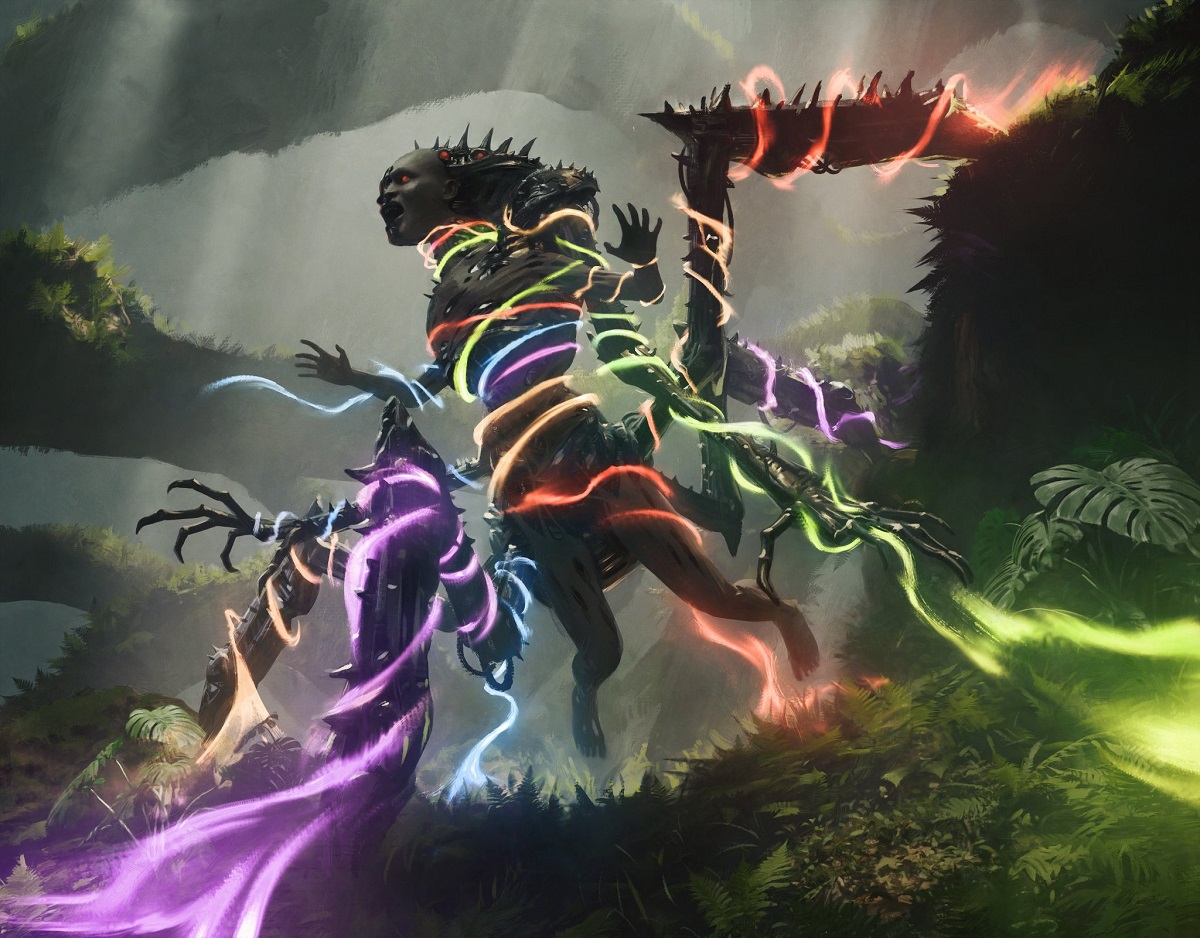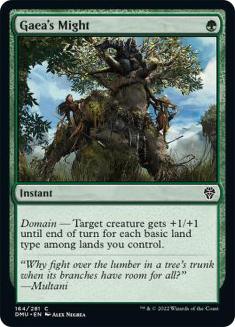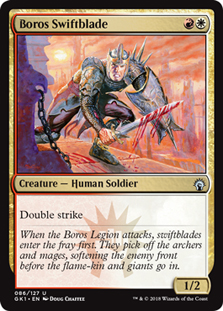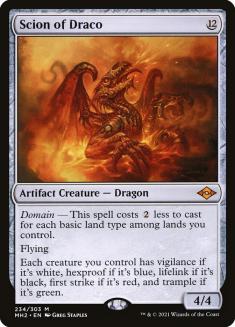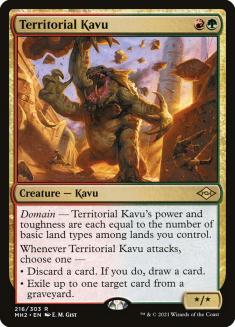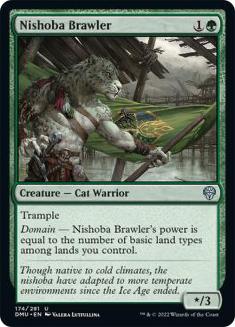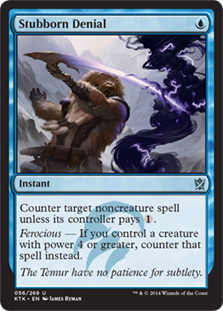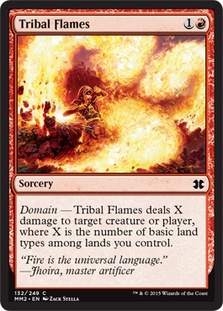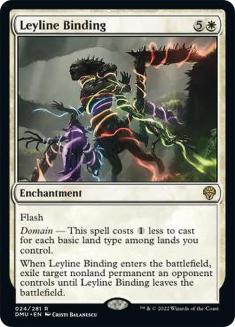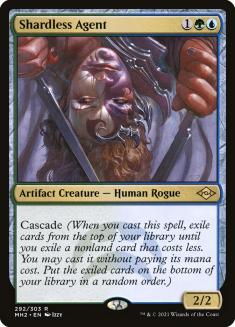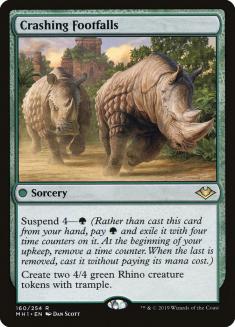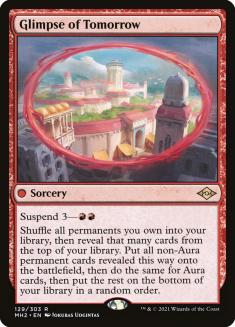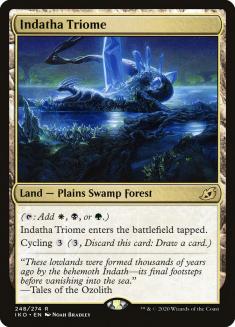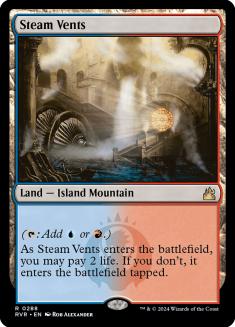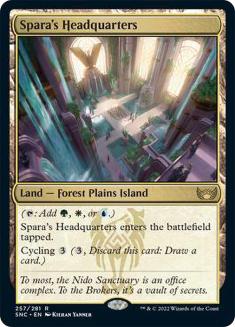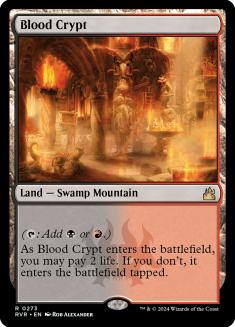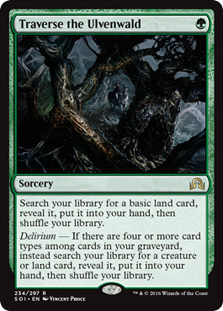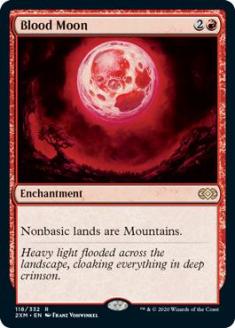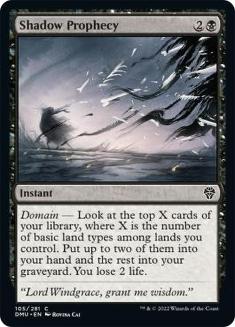Dominaria United brought some of the plane’s favourite mechanics out of retirement for one last hurrah. Domain was a smash hit when Invasion introduced it over twenty years ago, and it’s no surprise that Magic has come back to it repeatedly. In Modern, the combination of fetchlands and shocklands or Triomes (finally a complete cycle thanks to Streets of New Capenna) makes domain a trivial threshold – but what does that get you?
Domain Throwbacks
Domain Zoo was once a staple of these larger formats. As I was getting into the game, I was captivated by a young Raphael Levy winning back-to-back Extended Grand Prix on opposite sides of the world with his Gaea’s Mights and Boros Swiftblades. When Extended became Modern, Zoo powered by Wild Nacatl was an early favourite – this flexible manabase gave you access to the best threats and best disruption across the colour pie – until Nacatl itself was banned to promote other creature decks. Years later, Nacatl was cautiously released back into the wild, but nobody even cared. The format had moved past not only Nacatl but also the deck that was its natural habitat.
Modern Horizons 2
Modern Horizons 2 made a valiant effort to reintroduce this archetype to the Modern ecosystem, but this fell flat largely because of other predators in the same set. Unholy Heat and Prismatic Ending joined Fury and Solitude in pushing out creatures that relied on their stats and didn’t come with protection or insurance against removal. The set also enabled powerful proactive strategies that could ignore these bodies; even the pre-nerf versions of Scion of Draco and Territorial Kavu described by Sam Black in his look behind the curtain would be swept up by Living End or crushed by a Colossus Hammer.
Creatures (23)
- 4 Tarmogoyf
- 4 Wild Nacatl
- 4 Territorial Kavu
- 4 Scion of Draco
- 4 Ragavan, Nimble Pilferer
- 3 Nishoba Brawler
Lands (19)
Spells (18)

Nishoba Brawler
Nishoba Brawler adds another two-drop that is likely to be the biggest creature on any battlefield – and more likely to survive for at least a turn in a world where Unholy Heat has replaced Lightning Bolt as the default removal spell in many red decks. This wouldn’t change much by itself – Tarmogoyf is showing its age but still happily fills a similar role – but the specific stats on Nishoba Brawler let you chase a bigger prize.
Stubborn Denial
Stubborn Denial is one of the best counterspells of all time if you can enable ferocious reliably – and is even fine as a Force Spike sometimes if you are applying enough pressure that the opponent can’t wait around. Adding another five-power threat in Nishoba Brawler helps both halves of that offer.
Being in denial is especially appealing right now. Each of the three major Cascade decks has put up results recently. Five-Colour Indomitable Creativity is the deck to beat, and Grinding Breach is hot on its heels. Everywhere you look you find decks that sculpt the entire game around resolving their namesake noncreature spell – you can’t ask for a better response than Stubborn Denial.
Tribal Flames
This roster of hard-hitting threats changes the context for some former staples. Even fifteen years ago, Tribal Flames was a big reason to build your Zoo deck in this way, and drawing multiple copies was a way to steal lost games or win the race against faster linear decks. When your creatures are this strong and most opponents take damage from their own manabase, a few hits from one or two threats are enough to put them in burn range. Choosing to take a hit from a Kavu or Brawler to develop your battlefield because you can deal with it later may be a fatal error.
Leyline Binding
The newest domain card is a more complicated story for this deck. It gives you a welcome answer to the few creatures that can outsize yours, as well as overlapping coverage with Stubborn Denial against planeswalkers or cards like Underworld Breach, but it gives many of your opponents yet another cheap removal spell that doesn’t care how big your creatures are.
This approach to Domain Zoo deals with that problem through sheer redundancy, presenting a steady stream of threats that all demand immediate answers alongside a smattering of disruption. That won’t be enough to restore it to its former glory, but the early signs are that it may succeed in the general goal of making Domain Zoo a player again in Modern.
Leyline Binding is the reason that many other decks are dipping their toes into the domain mechanic for the first time.
Cascade
As a Modern player, the first thing you do with any new cost reduction or evasion clause is check how it works with cascade. Living End doesn’t have much interest in interaction that isn’t attached to a creature, and there’s a steep cost to warping your manabase around Leyline Binding for a deck that wants to have access to all its mana for cycling every turn.
However, Crashcade and Glimpse – and the 60- or 80-card variants of each of these – are in the market for this effect. Crashcade has historically had issues with creatures that outsize its Rhinos, from Tarmogoyf to Murktide Regent. Binding solves that issue, and moving into white opens the door for Teferi, Time Raveler and even Solitude as additional answers. Opposing copies of Teferi and a universally playable hate card in Chalice of the Void are issues for any Cascade deck, and Binding is cheap enough in the mid-game that you can cast it and your newly freed cascade spell in the same turn before that hate card can be replaced.
Manabase Construction
These Cascade decks are a good exercise in building a manabase to support Leyline Binding. Consider the Glimpse deck that I took to the finals of a Modern Challenge on MTGO a few weeks ago. Like most of the Four-Colour __ decks in Modern, it is based firmly in the Omnath, Locus of Creation colours, with black on the outside looking in.
If we want a fetchable Swamp to let Leyline Binding cost one mana (and the gap between one and two mana is so vast when it matters that I think you should), we want that final land type to be on a Triome rather than a shockland. An Overgrown Tomb is just a painful Forest in a non-black deck that has other specific colour requirements (a Tomb as well as an actual Forest won’t let you cast Omnath, for example). Similarly, our non-Binding lands may inform these choices. Glimpse already needs to play Khalni Garden, so there’s additional pressure to avoid lands that are effectively mono-green.
Two Lands, Five Colours
Our ideal fetchland sequence will involve finding a Triome on Turn 1 and then fetching a shockland or Triome that covers the other land types on Turn 2, with that first Triome letting us cast Binding. It’s easy to see that there are lots of pairs of two Triomes that cover this – you could fetch Raugrin Triome into Zagoth Triome just as easily as Savai Triome into Spara’s Headquarters – but each Triome has a specific shockland that it pairs with for total coverage.
For a Cascade deck, this double Triome sequence is tempting because you necessarily have few demands on your mana before Turn 3, but the incentives are different for a deck like Four-Colour Control (Yorion) where the ability to cast several spells in the same turn is important and part of Binding’s appeal. It’s self-defeating to jump through hoops so that one land can cast Binding if the other land can’t cast your Traverse the Ulvenwald or Unholy Heat.
This Glimpse deck wants to evoke Wavesifter on Turn 2 and ensure that this pair of lands can cast any of the Cascade spells – Violent Outburst, Shardless Agent, and Ardent Plea – on Turn 3 no matter what our third land is. Indatha Triome + Steam Vents satisfies all of these requirements and meshes well with the rest of the manabase. Steam Vents is a fine land to draw alongside Khalni Garden, for instance.
Four-Colour Control (Yorion)
Four-Colour Control (Yorion) has mostly been supplanted by other, equally colourful decks, but it is another natural home for Leyline Binding. Classic Four-Colour with Eladamri’s Call certainly wants Binding – and the ease with which it fits in there is a much-needed selling point for that version – but it’s less obvious for the delirium-focused version that is now the default. Unholy Heat covers a lot of the same ground as Binding, and you can’t add too much interaction to a deck that already leans heavily on Prismatic Ending and Solitude.
As a permanent you want to remain on the battlefield, Binding doesn’t contribute to delirium – and if it’s going to the graveyard from there, you may have bigger problems. Additionally, Traverse the Ulvenwald encourages you to play even fewer lands in an already land-light deck; finding room for the ‘off-colour’ Triome isn’t trivial, and Binding clashes with any utility lands like Boseiju, Who Endures or Otawara, Soaring City that give your Traverse more options in the mid-game.
Despite all that, some lists are adopting Leyline Binding anyway, a firm statement about its power from a deck with more options than any other.
Blood Moon
Leyline Binding is also notably better than the alternatives at answering Blood Moon, increasingly popular as a maindeck card again as a powerful weapon against the current top deck in Four-Colour Creativity as well as a source of free wins against many other decks. Needing basic lands in two colours makes Prismatic Ending unreliable here, whereas Binding just needs you to fetch a basic Plains at some point to be an effective – if expensive – answer. If you were able to diversify your basic lands to preserve Prismatic Ending as an out, Binding will be at least as cheap with the crucial advantage of having flash.
These four-colour decks pick up the lightest possible splash for Binding, but this set offers a compelling reason to run the full five.
Shadow Prophecy
‘Pure’ draw spells that don’t affect the battlefield or offer other options are out of fashion in Modern. Azorius Control might use Archmage’s Charm on your end step to refuel, but that card is only there because of everything else it can do. Expressive Iteration looks like an exception, but it has to be one of the best draw spells ever printed at a cheap price point to stick around. Fact or Fiction, an iconic draw spell that defined its era and looks similar to Shadow Prophecy, may as well not exist. The precedent here isn’t encouraging, but I think Shadow Prophecy can overcome it.
As a baseline, a fully-powered Prophecy compares favourably to the front half of Memory Deluge, one of the few draw spells that does show up and one that you rarely have time to flash back in some matchups. If you have enough graveyard synergies that dumping these other cards there powers up cards that are in your hand or unlocks more cards later, Prophecy suddenly looks like one of the best draw spells of all time.
Domain Meets Delirium
This domain-delirium crossover from aspiringspike ties all of these threads together. Shadow Prophecy isn’t just the perfect way to bridge the gap to Omnath, Locus of Creation or Soul of Windgrace; it’s all but guaranteed to give you delirium to turbocharge Traverse and Unholy Heat. This is a good proof of concept at 60 cards, and this template could extend to 80 cards for Yorion as the regular delirium deck does.
Reanimation
The above list cares about the graveyard in one sense. What if we decided to really care about it?
Creatures (16)
Planeswalkers (2)
Lands (18)
Spells (24)

Creatures (18)
Lands (18)
Spells (24)

Reanimator has picked up more tools than any other archetype in this era. Modern Horizons 2 brought the best reanimation spells in Persist and Priest of Fell Rites and the best target in Archon of Cruelty, while later sets gave strong enablers like Faithful Mending and Tainted Indulgence.
Despite that, the deck has lacked a crucial consistency. You often need to find exactly Persist and a creature to pair with it, and can’t spend too much time sifting through cards. You also run out of resources quickly, especially if you pursue the common backup plan of Ephemerate alongside Grief and Solitude. Shadow Prophecy excels at finding your combo pieces and getting them in the right zones while putting you up on cards and letting you work towards a longer game (by binning Priest of Fell Rites and finding the lands to unearth it, for example).
It’s hard for any mechanic to make the jump to Modern beyond a card or two that ends up being remembered in its own right; we think of Ledger Shredder, not connive. Domain has finally become one of those rare exceptions. This batch of domain cards will make their mark in Modern for a while to come.

